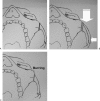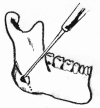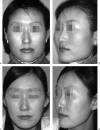Facial contouring surgery for asians
- PMID: 20567722
- PMCID: PMC2884897
- DOI: 10.1055/s-0028-1110098
Facial contouring surgery for asians
Abstract
Asian people, especially women, prefer a more delicate and feminine facial shape. To achieve a softer and better facial contour, there are several procedures to change the facial skeleton. Reduction malarplasty and mandibular angleplasty are common facial contouring operations in Asia. A lot of techniques have been developed independently by several authors. Various approaches can be chosen, such as intraoral or external skin incisions. There as also different contouring methods that can be chosen depending on the patient's morphology and the surgeon's technical preferences. The different osteotomy techniques used to mobilize the zygomatic complex can be classified according to the specific portion that is being repositioned. Resection and contouring methods for a prominent mandibular angle can be subdivided according to the specific type of anomaly. The purpose of this article is to review the concepts and various operative procedures for reduction malarplasty and angleplasty. The authors propose a guideline for selecting the appropriate procedure(s) for individual patients. Decisions should be made according to the patient's need, anatomic variations, and possible operative sequelae.
Keywords: Asians; Facial contouring surgery; aesthetic surgery; angleplasty; malarplasty.
Figures








Similar articles
-
Experience in East Asian facial recontouring: reduction malarplasty and mandibular reshaping.Arch Facial Plast Surg. 2010 Jul-Aug;12(4):222-9. doi: 10.1001/archfacial.2010.48. Arch Facial Plast Surg. 2010. PMID: 20644225
-
True intraoral reduction malarplasty with a minimally invasive technique.Aesthetic Plast Surg. 1999 Sep-Oct;23(5):354-60. doi: 10.1007/s002669900298. Aesthetic Plast Surg. 1999. PMID: 10541850
-
The importance of shaving the zygomatic process during reduction malarplasty.Int J Oral Maxillofac Surg. 2016 Aug;45(8):1002-5. doi: 10.1016/j.ijom.2016.01.001. Epub 2016 Jan 22. Int J Oral Maxillofac Surg. 2016. PMID: 26811071
-
Zygoma and Mandibular Angle Reduction: Contouring Surgery to Correct the Square Face in Asians.Oral Maxillofac Surg Clin North Am. 2023 Feb;35(1):83-96. doi: 10.1016/j.coms.2022.06.003. Epub 2022 Nov 3. Oral Maxillofac Surg Clin North Am. 2023. PMID: 36336603 Review.
-
Current Practices for Esthetic Facial Bone Contouring Surgery in Asians.Clin Plast Surg. 2023 Jan;50(1):71-80. doi: 10.1016/j.cps.2022.08.002. Clin Plast Surg. 2023. PMID: 36396263 Review.
Cited by
-
A New Simplified Visual Assessment Tool Describing Facial Morphotypes Observed and Desired in Asian Populations.J Clin Aesthet Dermatol. 2020 Apr;13(4):23-34. Epub 2020 Apr 1. J Clin Aesthet Dermatol. 2020. PMID: 33144908 Free PMC article.
-
Effect of hydroxyethyl cellulose soluble hemostatic gauze on hemostasis in facial contouring surgery.Medicine (Baltimore). 2021 May 14;100(19):e25847. doi: 10.1097/MD.0000000000025847. Medicine (Baltimore). 2021. PMID: 34106626 Free PMC article. Clinical Trial.
-
A Novel Six-Point Supraperiosteum Injection with Calcium Hydroxyapatite for Jawline Refining and Facial Anti-aging in Asian Patients.Aesthetic Plast Surg. 2025 Jul 3. doi: 10.1007/s00266-025-05045-x. Online ahead of print. Aesthetic Plast Surg. 2025. PMID: 40610809
-
Measuring patient-reported outcomes in orthognathic surgery: Linguistic and psychometric validation of the Mandarin Chinese version of FACE-Q instrument.Biomed J. 2020 Feb;43(1):62-73. doi: 10.1016/j.bj.2019.05.011. Epub 2020 Mar 4. Biomed J. 2020. PMID: 32200957 Free PMC article.
References
-
- Baek S M, Chung Y D, Kim S S. Reduction malarplasty. Plast Reconstr Surg. 1991;88:53–61. - PubMed
-
- Whitaker L A. Aesthetic augmentation of the malar-midface structures. Plast Reconstr Surg. 1987;80:337–346. - PubMed
-
- Powell N B, Riley R W, Laub D R. A new approach to evaluation and surgery of the malar complex. Ann Plast Surg. 1988;20:206–214. - PubMed
-
- Cho B C, Lee J H, Baik B S. Reduction malarplasty using sliding setback osteotomy. J Craniofac Surg. 1998;9:275–279. - PubMed
-
- Hinderer U T. Malar implants for improvement of the facial appearance. Plast Reconstr Surg. 1975;56:157–165. - PubMed

